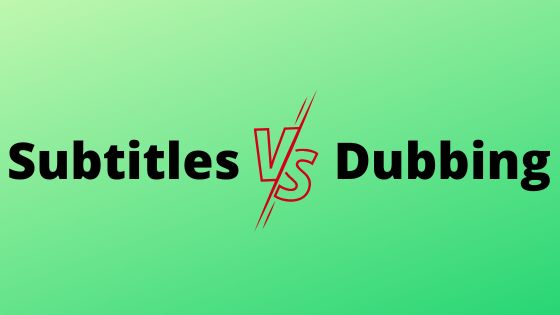Subtitles vs. dubbing? Since we live in a technological era, various smart devices and programs are part of our everyday lives. Due to up-to-date video-making software programs, creating a professional video is no longer a challenging tech process.

Video is a highly versatile tool used for many purposes besides standard filming. Content creators, producers, and animators can’t imagine their working routine without video production as it has conquered the digital world. As a result, most producers start going beyond the usual video making aimed at local viewers and strive to engage audiences around the globe.
The want to reach global audiences comes with the need to create content in multiple native languages. Therefore, there is an acute need among video makers for high-quality and lightning-fast tools to make this a possibility. Subtitle and dubbing services are exactly what they strive for. So, let’s figure out what’s more effective, subtitles vs. dubbing in film, animation, and online content.
Subtitles vs. Dubbing: The Difference
Before we immerse ourselves in exploring the contrast between subtitles and dubbing, it is worth understanding what they mean.
Subtitles are the textual accompaniment appearing typically on the screen’s bottom and transcribing the content’s dialogue. Subtitles also allow accessibility for those who are hard of hearing, making clear difficult-to-understand accents and an option to watch content without sound at all.
Dubbing is a more complex production process. It covers replacing the original speech throughout the film or content with a requisite language in post-production. This requires a script translation, casting voice actors, re-recording dialogue, and placing it in the project with a perfect time sync.
Subtitle Benefits
If you prefer watching movies in their pristine form, subtitles are the best choice. You won’t come upon any alterations to voice acting and may enjoy the original voices, catching all the nuances and hints conceived by the director and initial voice performance. The benefits of subtitles include:
1. Accessibility. If a person is hard of hearing, dubbing isn’t the answer. Subtitles will allow more people who previously couldn’t watch your content to enjoy and engage in it.
2. Learning languages. Many people use subtitled films to learn a second language. Simultaneous listening to the speech and reading the text will aid your brain in linking words together and remembering them. With such regular activity, you can master a new language over time.
3. Accuracy. Subtitles are incredibly close to the original script since they don’t need any changes for mouth motions to match the visuals. Dubbing often involves adapting the script so dialogue lasts the same length as the previous language, which can slightly change what is said.
Dubbing Benefits
The key advantage is complete immersion in audio-visual content and relaxation since there is no need to burden yourself with reading.
1. Global distribution. Film dubbing is typically produced in multiple languages, so it is decisive for spreading a film worldwide and the growing size of audiences.
2. Advantageous for animation. Dubbing is even easier with animated productions as mouth movements are less visually specific than live-action.
3. Covering all ages. Generally, children aren’t a fan of subtitles, and that’s if they can read at all. Content aimed at children or the family will benefit more from dubbing as it allows them to enjoy the content with ease.
Though subtitling vs. dubbing services each provide you with their different pros, combining both has one main advantage:
4. Choice. By adding both options, you allow your audience to choose how to consume translation. So, such a customizable approach attracts more people to your video content.
Get started with dubbing and subtitles today to expand your audience and boost your content to every corner of the globe.
